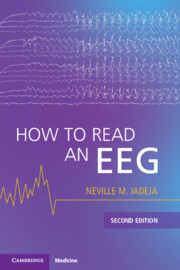
-
Select format
-
- Publisher:
- Cambridge University Press
- Publication date:
- 27 September 2025
- 24 July 2025
- ISBN:
- 9781009539210
- 9781009539227
- Dimensions:
- Weight & Pages:
- Dimensions:
- (234 x 156 mm)
- Weight & Pages:
- 0.59kg, 352 Pages
You may already have access via personal or institutional login
Book description
The EEG is a widely available neurophysiological test that, if interpreted correctly, provides valuable insight into brain function. Thoroughly revised for its second edition, this book demystifies their interpretation using a systematic approach that will benefit those looking to learn the art and science of EEG interpretation. Presented in three sections, the first delivers the foundational technical knowledge of how EEGs work, the second concentrates on a stepwise approach to analysing waveforms. The third section contains examples of EEGs in common scenarios, enabling readers to correlate their findings with clinical indications. Report writing is covered in depth in the appendix. Heavily illustrated with over 200 actual EEG examples, this is an essential handbook for all those seeking to learn and practice EEG reading. Perfect for residents, fellows, medical students on neurology/EEG electives, neurodiagnostic technologists, and experienced neurologists interested in an EEG refresher.
Contents
Metrics
Full text views
Full text views help Loading metrics...
Loading metrics...
* Views captured on Cambridge Core between #date#. This data will be updated every 24 hours.
Usage data cannot currently be displayed.
Accessibility standard: WCAG 2.2 AAA
Why this information is here
This section outlines the accessibility features of this content - including support for screen readers, full keyboard navigation and high-contrast display options. This may not be relevant for you.
Accessibility Information
The PDF of this book complies with version 2.2 of the Web Content Accessibility Guidelines (WCAG), offering more comprehensive accessibility measures for a broad range of users and attains the highest (AAA) level of WCAG compliance, optimising the user experience by meeting the most extensive accessibility guidelines.
Content Navigation
Table of contents navigation
Allows you to navigate directly to chapters, sections, or non‐text items through a linked table of contents, reducing the need for extensive scrolling.
Index navigation
Provides an interactive index, letting you go straight to where a term or subject appears in the text without manual searching.
Reading Order and Textual Equivalents
Single logical reading order
You will encounter all content (including footnotes, captions, etc.) in a clear, sequential flow, making it easier to follow with assistive tools like screen readers.
Short alternative textual descriptions
You get concise descriptions (for images, charts, or media clips), ensuring you do not miss crucial information when visual or audio elements are not accessible.
Full alternative textual descriptions
You get more than just short alt text: you have comprehensive text equivalents, transcripts, captions, or audio descriptions for substantial non‐text content, which is especially helpful for complex visuals or multimedia.
Visual Accessibility
Use of colour is not sole means of conveying information
You will still understand key ideas or prompts without relying solely on colour, which is especially helpful if you have colour vision deficiencies.
Use of high contrast between text and background colour
You benefit from high‐contrast text, which improves legibility if you have low vision or if you are reading in less‐than‐ideal lighting conditions.

